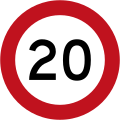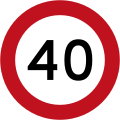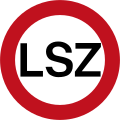
Speed limits on road traffic, as used in most countries, set the legal maximum speed at which vehicles may travel on a given stretch of road. Speed limits are generally indicated on a traffic sign reflecting the maximum permitted speed, expressed as kilometres per hour (km/h) or miles per hour (mph) or both. Speed limits are commonly set by the legislative bodies of national or provincial governments and enforced by national or regional police and judicial authorities. Speed limits may also be variable, or in some places nonexistent, such as on most of the Autobahnen in Germany.

A dual carriageway (BrE) or a divided highway (AmE) is a class of highway with carriageways for traffic travelling in opposite directions separated by a central reservation (BrE) or median (AmE). Roads with two or more carriageways which are designed to higher standards with controlled access are generally classed as motorways, freeways, etc., rather than dual carriageways.

A limited-access road, known by various terms worldwide, including limited-access highway, dual-carriageway, expressway, and partial controlled-access highway, is a highway or arterial road for high-speed traffic which has many or most characteristics of a controlled-access highway, including limited or no access to adjacent property, some degree of separation of opposing traffic flow, use of grade separated interchanges to some extent, prohibition of slow modes of transport, such as bicycles, horse-drawn vehicles or ridden horses, or self-propelled agricultural machines; and very few or no intersecting cross-streets or level crossings. The degree of isolation from local traffic allowed varies between countries and regions. The precise definition of these terms varies by jurisdiction.

A controlled-access highway is a type of highway that has been designed for high-speed vehicular traffic, with all traffic flow—ingress and egress—regulated. Common English terms are freeway, motorway and expressway. Other similar terms include throughway and parkway. Some of these may be limited-access highways, although this term can also refer to a class of highways with somewhat less isolation from other traffic.

Road speed limits in Ireland apply on all public roads in the state. These are signposted and legislated for in kilometres per hour. Speed limits are demarcated by regulatory road signs. These consist of white circular signs with a red outline. Speed limits are marked in black with "km/h" below the speed limit. Smaller "repeater" speed limit signs are used along stretches of road where there is no change in speed limit, in order to remind motorists currently on the road and to inform traffic merging from junctions that a certain speed limit applies.
Speed limits in Australia range from 5 km/h (3.1 mph) shared zones to 130 km/h (81 mph). Speed limit signage is in km/h since metrication on 1 July 1974. All speed limits are multiples of 10 km/h – the last digit in all speed signs is zero. Speed limits are set by state and territory legislation albeit with co-ordination and discussion between governments.
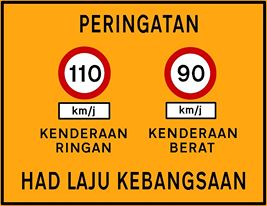
Had Laju Kebangsaan (National Speed Limits) is a set of speed limits applicable on Malaysian expressways, federal roads, state roads and municipal roads. The National Speed Limits was enforced on 1 February 1989 following the National Speed Limit Orders 1989 (Perintah Had Laju Kebangsaan 1989). Like any other countries in the world, failing to obey the speed limit on Malaysian roads and expressways is an offence as subject to Malaysian Road Safety Act 1987, which can be fined up to RM300, depending on the difference between the speed limit and the driven speed.

A speed limit is the limit of speed allowed by law for road vehicles, usually the maximum speed allowed. Occasionally, there is a minimum speed limit. Advisory speed limits also exist, which are recommended but not mandatory speeds. Speed limits are commonly set by the legislative bodies of national or local governments.

Road signs in Thailand are standardized road signs similar to those used in other nations but much of it resembles road signage systems used in South American countries with certain differences, such as using a blue circle instead of a red-bordered white circle to indicate mandatory actions. Until the early 1980s, Thailand closely followed American, European, Australian, and Japanese practices in road sign design, with diamond-shaped warning signs and circular restrictive signs to regulate traffic. The Department of Railway maintains a standard on the typeface used in the sign, with custom made type for Thai text, unofficially named “Thang Luang”(อักษรทางหลวง) and a small derivation of FHWA Series fonts typeface, which is used on American road signage, for Latin text. It should be noted that in most Bangkok Metropolitan Area's routes, TS Lopburi is still used.
This article describes the highway systems available in selected countries.

Road speed limits in the United Kingdom are used to define the maximum legal speed for vehicles using public roads in the UK.

Speed limits in Germany are set by the federal government. All limits are multiples of 10 km/h. There are two default speed limits: 50 km/h (31 mph) inside built-up areas and 100 km/h (62 mph) outside built-up areas. While parts of the autobahns and many other freeway-style highways have posted limits up to 130 km/h (81 mph) based on accident experience, congestion and other factors, many rural sections have no general speed limit. The Road Traffic Regulations (StVO) section on speed begins with the requirement which may be rendered in English:
Any person driving a vehicle may only drive so fast that the car is under control. Speeds must be adapted to the road, traffic, visibility and weather conditions as well as the personal skills and characteristics of the vehicle and load.

French roads have a variable maximum speed limit that depends on weather conditions. In dry weather rural 2- or 3-lane roads are limited to 80 km/h, 4-lane expressways 110 km/h, and highways 130 km/h. When raining, the limits are respectively lowered to 80, 100, and 110 km/h. Urban speed limit of 50 km/h is unaffected by weather. The general speed limit is lowered to 50 km/h on all roads in the fog or other low-visibility conditions if visibility is under 50 metres.

The default speed limits in the Netherlands are 50 km/h (31 mph) inside built-up areas, 80 km/h (50 mph) outside built-up areas, 100 km/h (62 mph) on expressways (autowegen), and, as of 16 March 2020, 100 km/h from 6:00 to 19:00 and 130 km/h from 19:00 to 6:00 on motorways (autosnelwegen).
The general speed limit in Hong Kong is 50 km/h, which applies to all roads unless signed otherwise.

Statutory speed limit in Japan defaults to 100 km/h (62 mph) for divided national expressways and 60 km/h (37 mph) for any other roads, unless otherwise posted. Urban two-way streets are usually zoned at 40 km/h (25 mph) or less.
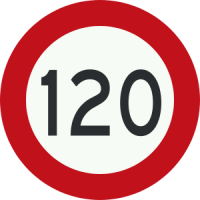
Speed limits in Pakistan are similar to most European countries on newer roads with most highways at 120 km/h (75 mph), and somewhat higher in the western areas of the country. There are some areas of the country with no enforced speed limit.

In South Korea, speed limits are controlled at the national level by Article 19 of the Enforcement Regulations of the Road Traffic Act, although speed limits can be lowered if deemed necessary, or if they are going through cities, towns, villages, or school zones. These speed limits are as follows:

The Netherlands has a public road network totaling 139,000 km, one of the densest in the world. Its use has increased since the 1950s and now exceeds 200 billion km traveled per year, three quarters of which is by car, making it among the most intensely used road networks. In 2019, the World Economic Forum ranked the quality of Dutch road infrastructure as the best in Europe and second to Singapore out of 141 countries.

Speed limits in the United States vary depending on jurisdiction. Rural freeway speed limits of 70 to 80 mph are common in the Western United States, while such highways are typically posted at 65 or 70 mph in the Eastern United States. States may also set separate speed limits for trucks and night travel along with minimum speed limits. The highest speed limit in the country is 85 mph (137 km/h), which is posted on a single stretch of tollway in exurban areas outside Austin, Texas. The lowest maximum speed limit in the country is 30 miles per hour (48 km/h) in American Samoa.


